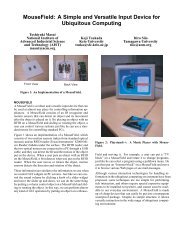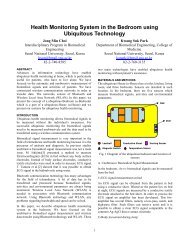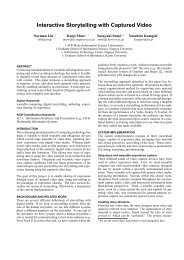Workshops - UbiComp
Workshops - UbiComp
Workshops - UbiComp
- No tags were found...
Create successful ePaper yourself
Turn your PDF publications into a flip-book with our unique Google optimized e-Paper software.
system, reflex arcs, and even muscles are organs whose artificialstimulation allows the transformation of perception.That electrical activity has the ability to interact with the humanpercepts has been long known: “In his 1820 dissertation,Bohemian physiologist Johann Purkyne reported thata galvanic current flowing through the head upset balanceand equilibrium” [6]. This technique has recently been employedby researchers who have built wearable devices toalter sense of balance as well as provide a “virtual sense ofacceleration” [13].Cutaneous rabbit illusion is an interesting perceptual illusionin which a series of taps produced by actuators at discrete locationsfeel as if they are interspersed between the actuatorsunder particular timing conditions [8]. This phenomena hasbeen exploited by a variety of haptic devices to provide stimulationin areas between actuators. For instancea3x3“rabbit”display composed of vibrator was used to communicatedirectional cues [22].Another phenomena which has been exploited to transformperception is that of sensory substitution. Early attemptslooked at using vibrating stimulators to convey visual picturesusing an array built into a dental chair [1]. Experimentsshowed that visually impaired participants could “learn torecognize ... the layout of objects on a table in depth and incorrect relationship.”Synesthesia (literally: joining of perception) has been inducedin humans using a variety of methods, including electricalstimulation [5]. Less invasively, it may also be simulatedthrough the use of devices which map the informationof one senses onto another. This is the case with Fingersightdevices, including one that allows wearers to feel opticaledges as oscillations of a solenoid mounted above thefingertip [21].We have developed a number of systems that seek to augmentthe percepts and specifically make use of the body orreflexes as part of interaction [18]. Earlier work on laserbasedtracking systems [15] led us to think of how opticalbased information might be felt by users, which led us toradar and antennae as metaphors for interaction.HAPTIC ANTENNAEWe began to experiment with the concept of artificial antennaeas part of device illustrating another concept: HapticRadar [4]. This is a project that seeks to augment spatialawareness by creating radar out of sensors which act to extendthe range of touch for the skin.As most humans have a copious amount of hair located ontheir head (at least at some point in their life), and our headsare something we wish to protect, we reasoned a headbanddevice would be a good first form factor to test.We devised a system linking pairs of infrared rangefindersto motor vibrators into a circular arrangement. An earlierpaper, Augmenting spatial awareness with Haptic Radar, detailsexperimental results concerning the Haptic Radar. Mostsaliently, we found that 86% of untrained participants coulduse the system to move to avoid objects they could notsee [3].Following these initial experiments, we began a redesignwith the aim to make individual, compact, Haptic Antenna.To replace the Arduino board, we selected an ATMEL ATtiny13RISC microcontroller for its compact size (4 mm x4mm). The process of reading from infrared rangefinder andcontrolling a vibrating motor requires a minimum of computationalresources so this 8-bit microcontroller operatingat 20 MHz is adequate.After recreating and testing the system on breadboard, weadded a 100 milliampere-hour lithium-ion polymer batteryas well as charging circuitry. After testing this through-holetechnology circuit, we designed and fabricated a surfacemounttechnology printed circuit board (using the freelyavailable Eagle printed circuit board CAD software.)After further testing and circuit board revisions, we havearrived at a Haptic Antenna in a much more portable instantiation.The device melds a microcontroller, infraredrangefinder, motor-vibrator (a common part in portablephones), battery and electronics. Altogether, these componentsoccupy 25 cm 3 , which is a factor of 34 times smallerthan the previous version’s electronic system.AURAL ANTENNAEDuring this process we came to ask ourselves: what if peoplefelt directional sound as opposed to distance information?Imagine that a car is honking behind you but that you cannothear it because of a hearing impairment or environmentalnoise. Now imagine that the honking could be felt on thebody at the location nearest to the car’s horn.As a starting point to test this concept we have been buildingprototype audio-to-touch sensory substitution devices. AuralAntennae are compact, worn modules which produce vibrotactilestimulus in response to audio signals emanating froma particular direction.Principle of OperationOur current prototype builds upon the precious Haptic Antennaeplatform. Instead of a range finder, we attach adaughter board containing an electret microphone, conditioningresistors and capacitors as well as an OPA344 operationalamplifier configured with a gain of G = 100.The analog voltage output of the amplifier is digitized usingthe ATtiny’s internal 10 bit analog to digital converter.The microcontroller’s firmware samples the microphone atapproximately f s = 9000Hz.After each sample, the microcontroller computes a simplemoving average (SMA) over the previous k = 10 samples(1). The absolute difference (δ) is then computed betweenthe current sample s t and SMA (2).27






